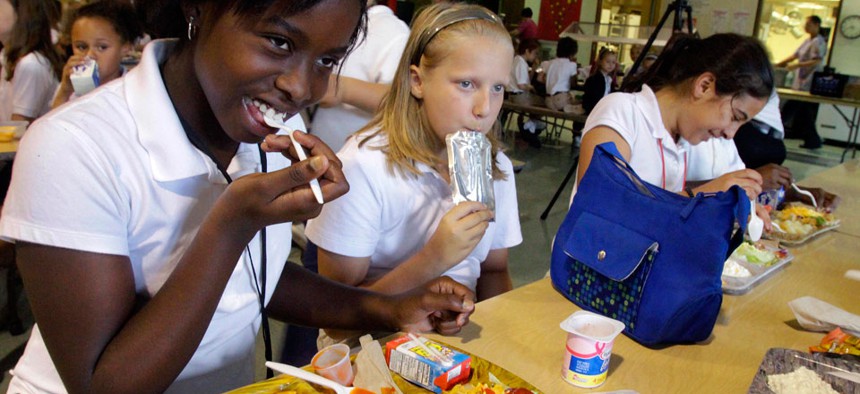Watchdog Warns of Potential Waste in Food Aid
IG says multiple low-income nutrition assistance programs increase risk of duplicating benefits.
The government might be doling out too many benefits to children and needy families who receive multiple forms of food assistance, according to a new inspector general report.
The Agriculture Department administers 15 different food assistance programs to low-income individuals and households, increasing the risk of duplication and potentially providing total benefits that exceed 100 percent of recipients’ daily nutrition needs, the watchdog concluded. The extent of possible overlap in the food and nutrition programs is unknown though, because the department said it doesn’t have enough resources to adequately assess whether it’s wasting money. The Food and Nutrition Service believes “the network of nutrition assistance programs that make up the national nutritional safety net reflects Congress’ recognition of a diversity of needs, and does not present evidence of overlap and duplication.” Still, the agency agreed to include in its fiscal 2014 research and evaluation agenda a plan to study whether overlap exists among the 15 programs, and the resources necessary for such an assessment.
The assortment of FNS’ federal nutrition assistance programs, known as the “safety net,” had a fiscal 2012 budget of $114 billion. The bulk of that money -- $88.6 billion -- funds the Supplemental Nutrition Assistance Program, formerly known as the food stamp program and the agency’s primary nutrition program. The House on Thursday passed the 2013 farm bill omitting funding for the food stamp program for the first time since 1973. House Agriculture Committee Chairman Frank Lucas, R-Okla., said he would try to craft a separate bill to fund SNAP, according to a news report in The New York Times.
Other types of food aid target special populations and dietary needs, such as the Women, Infants and Children program, which provides healthy food to low-income recipients who are pregnant, breastfeeding or postpartum; the Child and Adult Care Food Program, which offers nutritious meals and snacks to eligible children and adults in day care; and the national school lunch and breakfast programs for needy children. In addition, Agriculture operates 10 smaller food assistance programs.
The network of aid is set up so that eligible recipients can participate in more than one program at a time, except in cases where there is clear overlap between programs. For example, children on SNAP can also enroll in the breakfast and lunch programs, but the agency prohibits simultaneous participation in SNAP and the Food Distribution Program on Indian Reservations. The Food and Nutrition Service estimates that 101 million people currently participate in at least one of its food assistance programs, including more than 47 million in SNAP, “a historically high figure that has risen with the economic downturn and expanded eligibility and funding of food assistance programs,” the IG report stated. A 2006 study that looked at multiple participation in the four major food assistance programs found that about 41 percent of families were enrolled in only one type of aid, while 59 percent participated in two or more programs.
“Since 2006, enrollment and budget figures for FNS’ programs have changed significantly,” the IG report said. “Without current data on multiple program participation and costs, the extent of the potential overlap and duplication currently in FNS programs is unknown.”
The watchdog said the agency could save money through identifying and eliminating possible inefficiencies -- particularly important in the current budget environment, and in light of President Obama’s 2011 directive to improve government management. The IG gave FNS credit for trying to streamline its portfolio of food assistance programs over the years, but said those efforts have “generally focused on individual programs or on the relationship between two of its programs” rather than the safety net as a whole.




